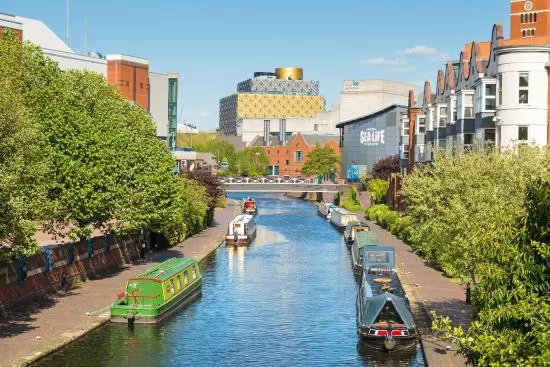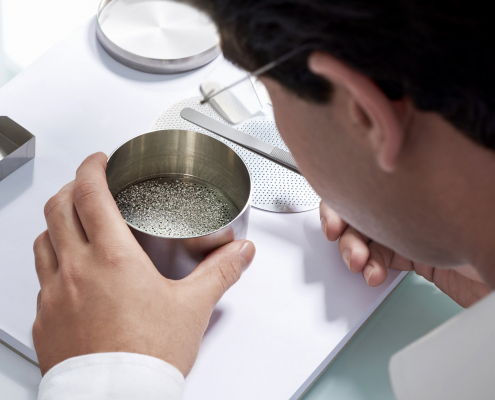History of The Jewellery Quarter, Birmingham
The Jewellery Quarter is an historic neighbourhood located in the heart of Birmingham, England. The area has a rich history dating back to the 18th Century and has played a significant role in the development of the UK’s jewellery industry.
In the late 1700s, Birmingham emerged as a major centre of jewellery manufacturing in England, due to its central location and a ready supply of raw materials such as metals and coal. By the early 1800s, the Jewellery Quarter had become established as the hub of the country’s jewellery industry. A large number of workshops and factories produced everything from simple silverware to elaborate gold jewellery.
Birmingham’s canal network

The construction of Birmingham’s canal network increased the supply of raw materials and fuel, and throughout the 19th and early 20th centuries, the Jewellery Quarter continued to thrive, attracting skilled craftsmen, designers and diamond suppliers from all over the country. During this time, many of the area’s factories and workshops were built, and the distinctive Victorian architecture of the Quarter came to define its character. Jewellers in the area developed innovative manufacturing techniques and cutting-edge technology, which helped to establish Birmingham’s reputation as a world leader in jewellery production.
In the mid-20th century, the UK’s jewellery industry began to decline, as cheaper manufacturing was available overseas and competition increased. Despite this, the Jewellery Quarter remained a hub of activity, with many of its workshops and factories continuing to produce and trade in high-quality jewellery. In the 1980s and 1990s, there was a renewed interest in the Quarter, as people began to rediscover its rich history and unique character.
Today, the Jewellery Quarter is a vibrant and thriving neighbourhood, with a mix of independent shops, museums, galleries, and cultural institutions. Many of the area’s historic buildings have been preserved and restored, and the Quarter is now a popular tourist destination, attracting visitors from all over the world. The Jewellery Quarter continues to be a symbol of Birmingham’s rich history and its contributions to the global jewellery industry.
People of the Jewellery Quarter
As well as a bustling centre of industry and commerce, the area was home to a large and diverse community of workers and their families. This community included jewellery makers, silversmiths, engravers, polishers and support staff.
Many of the workers who lived in the Jewellery Quarter were skilled craftspeople and women who had been trained in their trades from a young age. They worked long hours in the workshops and factories, often six days a week, and their work was both physically and mentally demanding.
The families of the workers were often closely involved in industrial life. Children would help out in their parents’ workshops and women would work as support staff, such as cleaners and caretakers. Many people lived in the crowded and cramped terraced houses that surrounded the workshops and factories.
As with much of Birmingham’s history as a ‘free city’, the community was shaped by migration over many centuries which has contributed to the diversity and vibrancy of the area.
Throughout the 19th and early 20th centuries, many Irish and Jewish migrants came to Birmingham and found work in the city’s growing jewellery-making industry. They quickly became an important part of the community in the Jewellery Quarter. The Jewish workers brought with them their own unique cultures and traditions, and they contributed to the rich cultural mix that made the Quarter such a vibrant and interesting place.
Post-War Immigration: In the decades following World War II, Birmingham saw a large influx of immigrants from the Caribbean, South Asia, Hong Kong and other parts of the world. These immigrants brought with them new skills, new perspectives, and new cultures, and helped revitalise the Jewellery Quarter and to bring new life to its workshops and factories.
Workers of the Jewellery Quarter

The workers of the Jewellery Quarter were proud of their trade and their community, and formed close-knit social networks and communities.
As a family business, we at Pala Diamonds value our own story as part of this history. In the late 20th Century, our family built a reputation in the Jewellery Quarter, building on the expertise of five generations across three continents. The demand for diamonds in recent decades spurred us to reinvent our brand as Pala Diamonds in 2010, specialising in ethically-sourced, high-quality diamonds.
Like our business, the Jewellery Quarter has evolved to become a much different place, but it’s still home to many jewellers and diamond dealers. The legacy of these pioneering workers and their families lives on, and their hard work and dedication to the trade continue to be celebrated and remembered.
Historic Buildings in the Jewellery Quarter

The Jewellery Quarter in Birmingham is home to a wealth of historic buildings that offer a glimpse into its rich history and heritage. With distinctive Victorian architecture and 20th Century landmarks of manufacturing innovation, there is much to see.
Vyse Street
Vyse Street is a central street that runs through the middle of the Jewellery Quarter and is considered to be one of the most historic and important streets in the area. It was once the centre of the jewellery-making industry in Birmingham, and many of the street’s historic buildings were used as workshops and factories for the production of jewellery and silverware by firms such as M.H. Cotton and Co. and Henry Matthews. The architecture of the street is a mix of Georgian and Victorian buildings, many of which have been beautifully restored and preserved and are considered to be some of the finest in Birmingham. Along this street are a few historical landmarks to take note of during your visit.
The Silver Arcade
This historic building was once used as a showroom for silverware. Today, the Arcade is home to a range of independent retailers, selling everything from jewellery and crafts to clothing and gifts.
Museum of the Jewellery Quarter
Housed in a former Smith & Pepper jewellery factory at the north end of Vyse Street, this museum offers a unique insight into the history of the Jewellery Quarter and the jewellery-making industry in Birmingham. In this perfectly preserved workshop, visitors can see a range of artefacts, including tools, machinery, and finished jewellery pieces, as well as learn about the lives of workers who once lived and worked in the area. Unfortunately, the museum is currently closed except for special events, due to a lack of funding. The exterior of the building is still worth viewing, with two-tone decorative brickwork and beautiful Victorian arched windows.
St. John’s Church
St. John’s Church, located on Vyse Street, is a historic church that was built in the early 19th century. The church is considered to be one of the finest examples of Gothic Revival architecture in Birmingham, and it is a popular destination for visitors to the Jewellery Quarter.
The Big Peg
This iconic building, located on the corner of Warstone Lane and Vyse St, is one of the most recognisable landmarks of the Jewellery Quarter. Originally opened as The Hockley Centre in 1971, it was built to house the multiple jewellery workshops and factories that originally had poor-quality buildings on the site. This was part of a post-war redevelopment plan after the Quarter was badly bomb-damaged in World War 2. The nickname “The Big Peg” is said to have originated from the large wooden pegs that secured the building’s timbers during construction. Today, The Big Peg is home to many businesses, including Pala Diamonds, and is considered a hub of innovation and creativity in the Jewellery Quarter. In 2022, the Big Peg was refurbished into spacious, modern offices and renamed “JQ Modern”.
Aside from those within walking distance of our offices, there are plenty of historic and architecturally interesting sites to visit during your time in the Jewellery Quarter, including The Pen Museum: a fascinating site showcasing the history of the fountain pen industry in Birmingham, with a range of antique pens, tools and machinery. St. Paul’s Square is a picturesque churchyard surrounded by beautiful Georgian and Victorian buildings and is considered to be one of the finest examples of Georgian architecture in Birmingham. This was once a popular spot for the workers of the Jewellery Quarter, who would gather here during their lunch breaks to socialise and relax. Finally, St. Anne’s Church is a historic church on Vittoria Street and one of the few remaining examples of Gothic Revival architecture in Birmingham.
Visit the Historic Jewellery Quarter and Learn More about our Industry

There are still many jewellers and diamond suppliers in the Jewellery Quarter, and many people travel to purchase items that have been crafted with the wealth of generational experience in the area. As diamond wholesalers, we often have visits from jewellers and diamond dealers who benefit greatly from visiting the historic sites that surround our offices. This is a fascinating and enlightening experience for all, turning a business trip into an adventure in one of the most historically significant parts of our city and industry.
